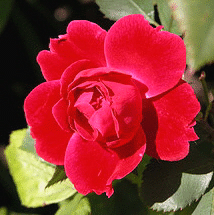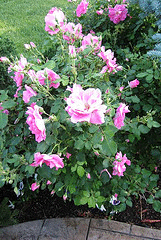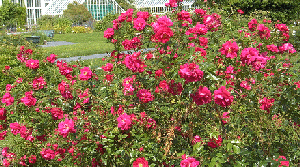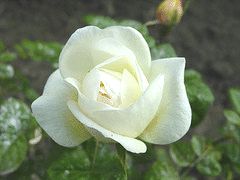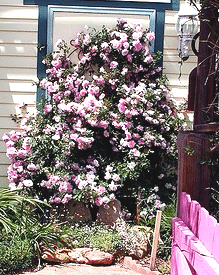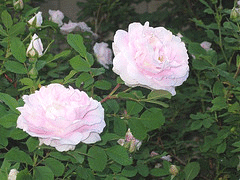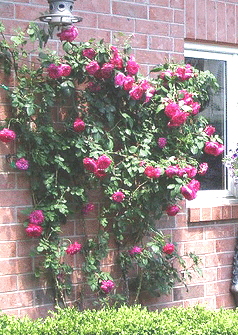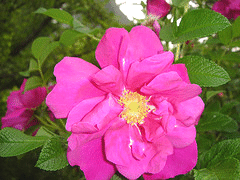Canadian Explorer Roses
Canadian Explorer Roses were developed to withstand the cold Canadian winters, but will also thrive in warm and humid summers. The Explorer roses are very easy to care for, needing minimal or no spraying for disease and insects, and are hardy to -35 C with only snow to protect them. Pruning requirements are minimal.
Canadian Explorer ‘Alexander Mackenzie’
Class: Shrub Rose, climbing rose
Sun: Full sun
Height: 5-6’
Spread: 4-7’
Growth Habit: Climbing upright
Bloom Color: Medium to deep red
Flower Form: Double, with a classic rose look
Flower Size: Medium, 2-3”
Petal Count: 40-50
Bloom Season: Repeat
Fragrance: Moderate raspberry scent
Stem: Thorned
Foliage: Glossy light green
Disease Resistance: Highly resistant to black spot and powdery mildew and rust
Soil: Enriched well drained
Hardiness: zone 3b-5
‘Alexander Mackenzie’s’ medium to deep red blooms have a classic look, resembling the blooms of grandiflora and hybrid tea roses. The blooms are born in large clusters of very full double blooms. The shrub grows vigorously, tall and upright. The foliage opens tinted with red, then matures to darker green. Blooms repeat minimally. Disease resistance is very good but may be slightly susceptible to powdery mildew. Prune spent blooms to encourage repeated blooms. This is a great shrub rose for groupings with its’ striking bloom color, or as a specimen plant, or in a shrub border. ‘Alexander Mackenzie’ will also make a wonderful pillar rose, climbing to 6 or 8 feet when left unpruned. Will survive to zone 3b without protection, further north protection is necessary. -25 to -35F may cause dieback, but the rose will grow back true from own roots. In spring, remove dead, diseased, and old canes. Cut back remaining canes by one third.
Canadian Explorer ‘Captain Samuel Holland’
Class: Shrub Rose
Sun: Full sun
Height: 6-10’
Spread: 5’
Growth Habit: Spreading, trailing
Bloom Color: Bright reddish pink
Flower Form: Double
Flower Size: Medium, 3”
Petal Count: 15-25
Bloom Season: Recurrent, June to frost
Fragrance: Slight fragrance
Stem: Thorned
Foliage: Glossy dark green
Disease Resistance: Highly resistant to black spot, powdery mildew and rust
Soil: Enriched well drained
Hardiness: zones 3-9
‘Captain Samuel Holland’ is an ideal pillar rose. It grows 6 to 10 feet tall with trailing canes that are just right to train for a pillar, arbor or fence. If left unsupported, the shrub will instead spread to a sprawling shrub. When grown in full sun the shrub flowers freely all season. Double blooms are born in clusters of 1 to 10, and make an excellent cut flower. Hips are ornamentally insignificant. Prune out one third of the oldest canes to the ground each spring to maintain an open form and encourage new cane growth. If growing as a shrub, also remove one third or more of the cane height to control size. The shrub is not too fussy about pH and soil type, and is fairly tolerant of urban conditions. Although very disease resistant, like most roses, ‘Captain Samuel Holland’ is susceptible to aphids and the Japanese beetle. Propagates easily from softwood cuttings. Will survive to zone 3a without protection, further north protection is necessary.
Canadian Explorer ‘Champlain’
Class: Shrub Rose
Sun: Full sun, will tolerate some shade
Height: 3-4’
Spread: 3-4’
Growth Habit: Compact
Bloom Color: Bright to dark red
Flower Form: Semi double
Flower Size: Medium to Large, 2 1/2-3”
Petal Count: 30
Bloom Season: Everblooming
Fragrance: Mild fragrance
Stem: Thorned, 5-10” long
Foliage: Glossy medium green
Disease Resistance: Some resistance to powdery mildew, little to moderate resistance to black spot.
Soil: Enriched well drained loam, slightly acidic
Hardiness: zone 3 and warmer
Brilliant red double blooms with dark edges are mildly fragrant and 2 1/2 to 3”, born singly on 5-10’ stems from June to October. Flowering is quite free and continuous without encouragement. Orange hips form in fall. ‘Champlain’ exhibits superior hardiness to zone 3, but will experience minor winter injury in zones 3 and 4 that requires tip pruning. Creates a nice informal hedge, pleasing in groupings in perennial or shrub borders, cottage gardens or foundation planting. Will survive to zone 3a without protection, further north protection is necessary.
Canadian Explorer ‘David Thompson’
Class: Shrub Rose, Rugosa parentage
Sun: Full sun
Height: 4-6’
Spread: 4-6’
Growth Habit: Compact, upright
Bloom Color: Very red
Flower Form: Double, flat
Flower Size: Medium to large, 2 1/2 - 3”
Petal Count: 25
Bloom Season: Repeating, June through September
Fragrance: Strong fragrance
Stem: Nearly thornless
Foliage: Serrated dark green leaves
Disease Resistance: Excellent resistance to blackspot, powdery mildew and rust
Soil: Enriched well drained
Hardiness: zone 2b - 7
‘David Thomson’ is a stunning shrub that flowers very freely all summer long. It is super hardy, surviving easily in zone 2 with no winter kill, and only occasional experiencing minor injury. Resistance to blackspot and powdery mildew is excellent, but the blooms are somewhat susceptible to the Japanese Beetle and aphids. With Rugosa parentage, ‘David Thomson’ does NOT like spraying with chemicals. Use as a specimen plant, in masses, for informal hedges or in shrub borders. Unfortunately, ‘David Thomson’ does not produce hips. The plant will propagate easily from softwood stem cuttings. Renewal prune each spring, head back to control size. Will survive to zone 2a without protection, further north protection is necessary.
Canadian Explorer ‘Frontenac’
Class: Shrub Rose
Sun: Full sun
Height: 3-4’
Spread: 3’
Growth Habit: Compact, upright
Bloom Color: Deep pink with white petal base
Flower Form: Semi double, in clusters
Flower Size: Medium to large, 3 - 3 1/2”
Petal Count: 20-25
Bloom Season: Repeating
Fragrance: Mild
Stem: Thorned
Foliage: Dark green
Disease Resistance: Good resistance to blackspot, powdery mildew and rust
Soil: Enriched well drained
Hardiness: zone 3 and warmer
‘Frontenac’ produces double blooms in clusters of 6 to 8, repeating floriferously. The shrub is nearly completely covered with blooms at its’ peak in June, then repeat blooming continues through September. Deep pink blooms don’t fade out, these are excellent cutting flowers. Use for mass plantings, foundation plantings, shrub borders or a striking low hedge. With consistent snow cover, ‘Frontenac’ sustains only minimal injury to zone 3. Will survive to zone 3a without protection, further north protection is necessary. The plant propagates easily from softwood cuttings.
Canadian Explorer ‘Henry Hudson’
Class: Shrub Rose, Rugosa parentage
Sun: Full sun, will tolerate some shade
Height: 2-4’
Spread: 3-4’ or more
Growth Habit: Compact, spreading
Bloom Color: White with a pink blush
Flower Form: Double
Flower Size: Medium to large, 3”
Petal Count: 20-25
Bloom Season: Repeating
Fragrance: Moderate clove fragrance
Stem: Thorned
Foliage: Deep green wrinkled
Disease Resistance: Excellent resistance to blackspot, powdery mildew and rust
Soil: Enriched well drained
Hardiness: zone 2 and warmer
Pink buds open to delicate white blooms with a pink tinge that are reminiscent of apple blossoms. In hotter weather the blooms will be more white. ‘Henry Hudson’ is a good repeat bloomer, blooming freely all season, but does need deadheading to induce additional heavy blooming. Orange-red hips are formed in fall. The shrub is super hardy, sustaining little to no injury as far north as zone 2. Will survive to zone 2a without protection, further north protection is necessary. “Henry Hudson’ makes an excellent low border plant for mixed beds, foundation planting or bedding plants. ‘Henry Hudson’ will sucker. The plant propagates easily from softwood cuttings.
Canadian Explorer ‘Henry Kelsey’ Climbing Rose
Class: Shrub Rose, climbing rose
Sun: Full sun to part shade
Height: 6-9’
Spread: 5’
Growth Habit: Climbing with long arching canes
Bloom Color: Deep red, maturing to medium rose red, with yellow centers
Flower Form: Double, in clusters
Flower Size: Medium to large, 2-3”
Petal Count: 25
Bloom Season: Repeating, beginning in early July
Fragrance: Light spicy scent
Stem: Thorned
Foliage: Glossy dark green tinged with burgundy
Disease Resistance: Some resistance to blackspot, highly resistant to powdery mildew
Soil: Enriched well drained
Hardiness: zone 2b and warmer
‘Henry Kelsey’ flowers quite freely, producing blooms in clusters of 9-18. The blooms open in a bright red and fade to a rose red as the bloom matures, then drop cleanly. Can be used as a climber or will form a tall shrub with arching canes. Or prune to control into a neater shrub. Will tolerate some shade and still produce good blooming. But be sure to plant where it will receive good air circulation to help prevent blackspot, and spray periodically for this disease. ‘Henry Kelsey’ can be left on the trellis over winter, requiring minimal pruning in spring. Will survive to zone 2b without protection, further north protection is necessary. Small orange hips are produced in fall. You won’t find a better performing red climbing rose for cold climates than ‘Henry Kelsey’.
Canadian Explorer ‘J.P. Connell’
Class: Shrub Rose
Sun: Full sun
Height: 5’
Spread: 4-7’
Growth Habit: Upright, bushy
Bloom Color: Creamy white
Flower Form: Double
Flower Size: Large, 3 - 3 1/2”
Petal Count: 30-70
Bloom Season: Repeat
Fragrance: Moderate fragrance
Stem: Nearly thornless
Foliage: Dark yellow-green
Disease Resistance: Good resistance to powdery mildew, somewhat susceptible to blackspot
Soil: Enriched well drained
Hardiness: zone 2b and warmer
Creamy white blooms with yellow centers are born singly or in clusters. Initially the petals are lemony yellow, then fade to cream. New blooms resemble hybrid tea roses with high centers, as they mature the bloom rounds and flattens to a classic shrub rose bloom. Young plants do not flower well, but after the second year it will flower heavily in June, then rebloom lightly through the rest of the season. ‘J.P. Connell’ is somewhat slow to establish, but displays excellent vigor after established. Blooms will become deeper colored, larger and more numerous as the plant becomes better established. Will survive to zone 2b without protection, further north protection is necessary. The plant propagates easily from softwood cuttings.
Canadian Explorer ‘Jens Munk’
Class: Shrub Rose, Rugosa parentage
Sun: Full sun, will tolerate part shade
Height: 4 1/2’
Spread: 4 1/2’
Growth Habit: Neat and tidy mounded shrub
Bloom Color: Bright candy pink with yellow centers
Flower Form: Semi double, somewhat flat, born in small clusters
Flower Size: Medium, 2 1/2 - 3 1/2”
Petal Count: 25
Bloom Season: Free flowering
Fragrance: Pleasantly scented, may not be as strong as most rugosas
Stem: Heavily thorned branches
Foliage: Wrinkled olive green leaves
Disease Resistance: Exceptionally resistant
Soil: Well drained, fertile
Hardiness: 2b - 8b
‘Jens Munk’ is a hybrid Explorer rugosa rose. The shrub stays neat in a smaller mounded shrub, making it a beauty in the front of a garden, as a specimen plant or as foundation plantings. The shrub grows quite vigorously and is tolerant of part shade. Will survive to zone 2b without protection, further north protection is necessary.
Canadian Explorer ‘John Cabot’ Climbing Rose
Class: Climbing Rose
Sun: Full sun
Height: 8-10’
Spread: 4’
Growth Habit: Climbing with arching canes
Bloom Color: Deep fuschia pink/red
Flower Form: Semi double, in clusters
Flower Size: Medium, 2 1/2 - 3”
Petal Count: 40
Bloom Season: Repeating
Fragrance: Light fragrance
Stem: Thorned
Foliage: Glossy green
Disease Resistance: Good resistance to blackspot, powdery mildew and rust
Soil: Enriched well drained
Hardiness: zone 2b-9
‘John Cabot’ was the first climbing rose in the Explorer series. The canes are strong and arching. It blooms heavily in June and July, then sporadically in August and September. Bloom color can vary between deep pink and red, generally starting in a deeper red color, maturing to a brighter pink. ‘John Cabot’ is hardy to zone 3, after severe winters additional spring pruning will be necessary. Will survive to zone 3 without protection, further north protection is necessary. The arching canes may be trimmed to form a large shrub or left untrained and unpruned it will grow tall with cascading branches, up to 8 feet wide. The plant propagates easily from softwood cuttings.
‘Canadian Explorer John Davis’ Climbing Rose
Courtesy of our reader, artist, author and photographer Judith Baker Montano.
Class: Climbing rose
Sun: Full sun
Height: 7’
Spread: 5’
Growth Habit: Trailing
Bloom Color: Pink with slightly yellow tones
Flower Form: Very double, in clusters
Flower Size: Medium, 3”
Petal Count: 40
Bloom Season: Free flowering, continuous
Fragrance: Spicy scent
Stem: Very few thorns
Foliage: Medium to dark green, glossy, leathery
Disease Resistance: High resistance to blackspot and powdery mildew
Soil: Enriched well drained
Hardiness: zone 2b and warmer
Courtesy of our reader, artist, author and photographer Judith Baker Montano.
‘John Davis’ produces spicy scented semi double 3 inch blooms in a glorious pink, with clusters of up to 17 blooms. The bloom form is reminiscent of old fashioned roses. Use this 6-8 foot climber on a trellis or allow to trail across the ground. Some resistance to blackspot and mildew. The plant propagates easily from softwood cuttings. Hardy to zone 3, may experience minimal winter injury in zones 3 and 4 that would require pruning. Will survive to zone 3a without protection, further north protection is necessary.
Canadian Explorer ‘Lambert Closse’
Class: Shrub Rose
Sun: Full sun
Height: 3-4’
Spread: 3-4’
Growth Habit: Upright
Bloom Color: White cuff with hot pink inner petals
Flower Form: Double, with a classic rose look in bud form and partially opened bloom
Flower Size: Large
Petal Count: 53
Bloom Season: June to September
Fragrance: Mild fragrance
Stem: Thorned
Foliage: Glossy green
Disease Resistance: Resistant to blackspot and powdery mildew
Soil: Enriched well drained
Hardiness: zone 2b and warmer
Stunning blooms with a classic rose look make excellent cut flowers. The flowers are born in clusters of 1 to 3. Buds are deep pink, then the opening blossom has pink center petals and the unfurled petals fade pale. A fully opened bloom is faded pink. ‘Lambert Closse’ repeat blooms sporadically through summer. Hips are produced in abundance. The compact size makes this shrub rose useful in small gardens, foundation plantings and front of the border garden. Slight winter injury may require pruning. Will survive to zone 2b without protection, further north protection is necessary. The plant propagates easily from softwood cuttings.
Canadian Explorer ‘Martin Frobisher’
Class: Shrub Rose, Rugosa parentage
Sun: Full sun, will tolerate some shade
Height: 5-6’
Spread: 4’
Growth Habit: Upright
Bloom Color: Light pink
Flower Form: Double
Flower Size: Medium, 2 1/2 - 3”
Petal Count: 25-40
Bloom Season: Continuous
Fragrance: Soft fragrance
Stem: Reddish brown bark, upper stems are nearly thornless
Foliage: Gray-green
Disease Resistance: Highly resistant to powdery mildew, occasional succumbs to mild blackspot
Soil: Enriched well drained
Hardiness: zone 2 and warmer
‘Martin Frobisher’ was the original Explorer rose, introduced in 1968. It flowers freely all summer, June through October, and grows vigorously. The bush tends to sucker, which can be dug out and planted if desired. The bush is well proportioned, only slightly taller than wide. Creates an excellent hedge, good for mass plantings, as a specimen plant or back of the border. Minor top injury may occur in northern climates, requiring tip pruning. Will survive to zone 2a without protection, further north protection is necessary. ‘Martin Frobisher’ also performs very well in hot regions. No hips are produced, but canes are reddish in winter.
Canadian Explorer ‘Royal Edward’
Class: Shrub Rose, ground cover
Sun: Full sun
Height: 1 1/2’
Spread: 2’
Growth Habit: Ground cover, trailing
Bloom Color: Medium pink
Flower Form: Double
Flower Size: Medium, 2”
Petal Count: 18
Bloom Season: Repeating
Fragrance: Slightly fragrant
Stem: Thorned
Foliage: Glossy green
Disease Resistance: Good resistance to black spot and powdery mildew
Soil: Enriched well drained
Hardiness: zones 3 and warmer
‘Royal Edward’ is a low spreading rose that is a wonderful selection for ground cover, rock gardens, foundation plantings or border plantings along a walkway. It is also lovely trailing out of a planter on the patio. Deep pink buds open to a medium pink , then mature to a pale pink. Blooms repeat well from June to September and are born in clusters of 1 to 17. ‘Royal Edward’ is super hardy and may show only slight winter injury when unprotected in zone 3. Will survive to zone 3a without protection, further north protection is necessary. Propagates easily from softwood cuttings.
Canadian Explorer ‘Quadra’
Class: Shrub Rose, climber
Sun: Full sun
Height: 5-6’
Spread: 2 1/2 - 3’
Growth Habit: Spreadin
Bloom Color: Dark red
Flower Form: Double, similar to heirloom blooms
Flower Size: Large, 3 - 3 1/2”
Petal Count: 66
Bloom Season: Recurrent
Fragrance: Good Fragrance
Stem: Thorned
Foliage: Emerges red, turns to deep green
Disease Resistance: Excellent resistance to black spot and powdery mildew
Soil: Enriched well drained
Hardiness: zones 3-9
‘Quadra’ produces blooms singly or in clusters of up to four. The large full blooms have curled inner petals that are shorter like an heirloom rose. The rich red blooms mature to lighter red, and repeats very well. ‘Quadra’ has a spreading habit that makes it easy to train as a climber, and the cut flowers are wonderful. This is a super hardy shrub rose than will only suffer minor tip damage in zone 3 without protection, but make SURE you get own root. Will survive to zone 3a without protection, further north protection is necessary. Propagates easily from softwood cuttings.
Canadian Explorer ‘Simon Fraser’
Class: Shrub Rose, ground cover
Sun: Full sun
Height: 2’
Spread: 2’
Growth Habit: Upright, low growing
Bloom Color: Medium pink
Flower Form: Single to semi-double
Flower Size: Medium, 2 1/2 - 3”
Petal Count: Single bloom - 6 Semi-double bloom 22
Bloom Season: Continuous
Fragrance: Slightly fragrant
Stem: Very few thorns
Foliage: Glossy dark green
Disease Resistance: Good resistance to black spot and powdery mildew
Soil: Enriched well drained
Hardiness: zones 3-9
‘Simon Fraser’ is a low growing shrub that serves wonderfully as a ground cover. Clusters of 1 to 4 single blooms cover this free flowering shrub rose in spring, followed by semi double blooms the rest of the season. Best flowering occurs when grown in full sun. Will survive to zone 3a without protection, further north protection is necessary.
Canadian Explorer ‘William Baffin’ Climbing Rose
Class: Climbing rose
Sun: Full sun, will tolerate some shade
Height: 5-9’
Spread: 6’
Growth Habit: Climbing with arching canes
Bloom Color: Deep pink to medium red
Flower Form: Double
Flower Size: Small to medium, 2 - 2 1/2”
Petal Count: 20
Bloom Season: Continuous
Fragrance: Slightly fragrant
Stem: Thorned
Foliage: Glossy green
Disease Resistance: Highly resistant to blackspot, powdery mildew and rust
Soil: Enriched well drained
Hardiness: zone 2a - 9b
Free flowering deep pink double blooms over 2”, born in clusters of up to 30. Blooms beginning in mid June to early or mid July, then continues until frost. Strong arching canes may reach up to 10 feet. The first year or two the plant will focus on foliage growth, prune only to thin out weak or crossed canes until it becomes established. Thereafter the shrub will be covered with blooms. ‘William Baffin’ can be left on it’s pillar over winter. Superior hardiness to zone 3, with minimal winter injury in zones 3 and 4. Further north protection is necessary. Will also tolerate periods of dry heat.
